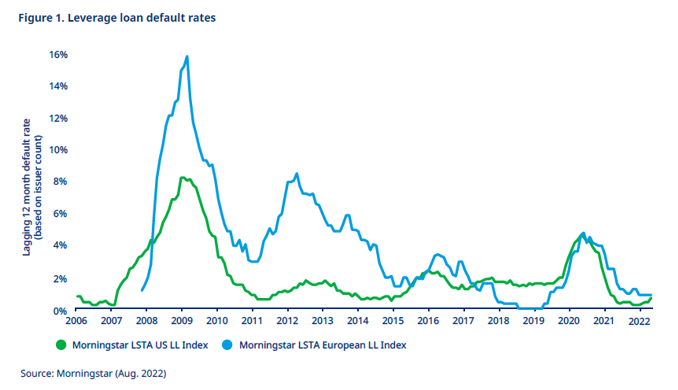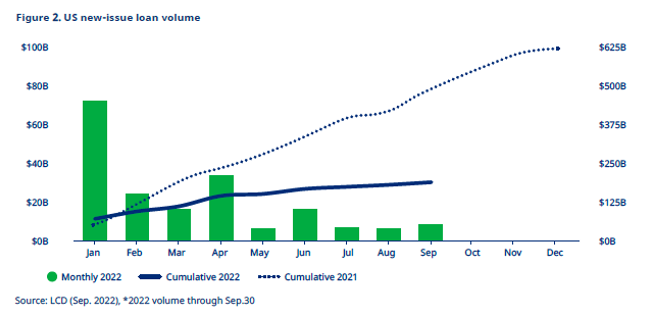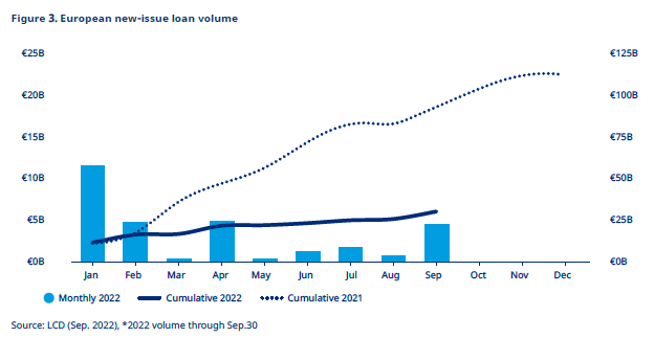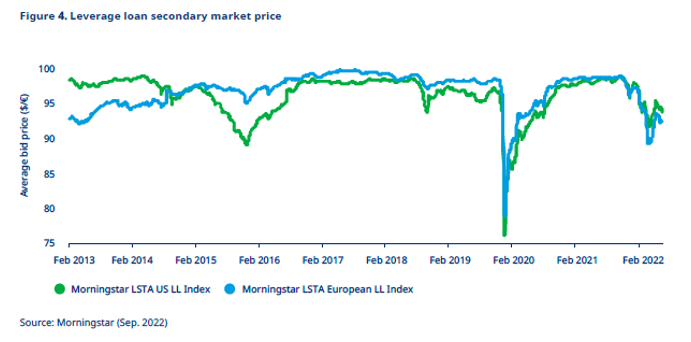Top considerations
for alternatives in 2023 – Private debt
“Success is where preparation and opportunity meet” — Bobby
Unser, Motorsports Hall of Fame
automobile racer
During 2022, the initial anxiety around whether or not inflation
would prove to be transitory rapidly transformed into substantial concern that
a tectonic shift in global monetary policy could result in a hard landing for
economic growth. Following the conflict in Ukraine and the ensuing supply chain
and energy price shocks, central banks raised interest rates in the face of
stark inflation readings. As we look to 2023, so far, performance in private
debt has remained steady*. By way of example, default rates in the broadly
syndicated leveraged loan indices in the US and Europe, which serve as a proxy
for private debt, remain at low levels.

However, a prevailing sense of uncertainty is clearly
reflected in market sentiment, with “traded” loan issuance falling
precipitously compared to the prior year, and the weighted-average bid for
loans falling steadily.



Where pricing volatility becomes a challenge for investors
and financing options are reduced for larger, “liquid” corporate borrowers,
private debt becomes an increasingly viable alternative to the liquid credit
markets. Combined with a predominantly floating-rate structure, private debt
offers one of the few bright spots on investors’ radars, despite the prognosis
for rising default rates across all credit asset classes.
Private debt has demonstrated a premium versus liquid credit
over a long period, often combined with lower default rates and higher recovery
rates.1 Given the current economic backdrop, it’s more crucial than
ever to build your allocation to private debt in the right way. Naturally, diversification
should be a core tenet for any private debt investor, and we strongly advocate
avoiding concentration risk. Taking this approach is playing defense at a time
when the market environment strongly suggests that more dispersion lies ahead —
between asset managers, investment strategies, sectors and portfolio companies.
In this paper, we choose to highlight another, perhaps
underappreciated, tenet for private debt investors: flexibility. A flexible
approach is not only defensive, but, to some extent, it can also be an attack.
To us, flexibility means:
•
Maintaining
broad coverage of the expanding landscape of private debt: Consider where
the imbalance of capital demand and supply is likely to be most acute over the
next 3-4 years. The world of corporate direct lending has traditionally
demonstrated this imbalance: reduced bank lending to the midmarket (supply) and
the rising requirement for debt capital from private equity (demand). As the
world of private debt continues to expand, we see new themes and avenues for
exploiting imbalances that may become even more acute over the next 3-4 years —
structured credit and specialty finance spaces, in particular —therefore
improving risk-adjusted return potential.
•
Cultivating
broader relationships: In the traditional model, investors commit assets to
a narrowly defined investment strategy. Instead, we advocate that investors
access broader credit platforms (that is, an asset manager with multiple credit
capabilities) with the potential to bring a diverse opportunity set together at
a single point of access. An asset manager that can look across its credit
platform has a higher probability of committing the next dollar of capital to the
best risk-adjusted return opportunity. The resulting portfolio should be more
robust, and able to achieve a greater level of diversification. Underwriting
the various underlying capabilities may mean more work, but we believe it is
worth it for the benefit of the overall portfolio.
•
Becoming
a provider of liquidity in stressed or dislocated situations: Periods of
secondary market volatility can escalate as a result of liquidity,
concentration and leverage limitations imposed on other market participants. We
believe opportunistic credit strategies are well placed to meet their higher return
targets when these circumstances proliferate in the wake of a broader credit
market dislocation. Being a provider of liquidity in these situations — whether
through secondary tranches of CLOs or individual broadly syndicated loans —
offers capital gain opportunities while allowing investors to retain a focus on
credit fundamentals and downside protection. The ability to pivot toward credit
dislocation funds, special situations and distressed debt at opportune points
in the cycle can be rewarding.
The
market environment is highly uncertain. In many respects, private debt
currently looks attractive, both on an absolute basis and relative to other
asset classes. However, there will be greater dispersion ahead. Opportunities
will present themselves as the asset class continues to expand and the
macroeconomic picture develops. In conjunction with diversification,
incorporating an element of flexibility into portfolio planning, construction,
and implementation can help private debt investors effectively prepare and
increase the odds of a successful outcome.
Key takeaways
Private debt is currently an attractive asset class, both on
an absolute basis and relative to other asset classes. However, there will be
greater dispersion ahead. Given the current economic backdrop, it is imperative
to build your allocation to private debt in the right way. Naturally, diversification
should be a core tenet of any private debt investor, and we strongly
advocate avoiding concentration risk.
* Past performance is no guarantee of future results.
1 For more information, see https://www.mercer.com/content/dam/mercer/attachments/global/gl-2022-private-debt-report.pdf
Important notices
References to Mercer shall be construed to include Mercer
LLC and/or its associated companies.
This contains confidential and proprietary information of
Mercer and is intended for the exclusive use of the parties to whom it was
provided by Mercer. Its content may not be modified, sold or otherwise
provided, in whole or in part, to any other person or entity without Mercer’s
prior written permission.
Mercer does not provide tax or legal advice. You should
contact your tax advisor, accountant and/or attorney before making any
decisions with tax or legal implications. This does not constitute an offer to
purchase or sell any securities. The findings, ratings and/or opinions
expressed herein are the intellectual property of Mercer and are subject to
change without notice. They are not intended to convey any guarantees as to the
future performance of the investment products, asset classes or capital markets
discussed.
For Mercer’s conflict of interest disclosures, contact your
Mercer representative or see www.mercer.com/conflictsofinterest.
This does not contain investment advice relating to your
particular circumstances. No investment decision should be made based on this
information without first obtaining appropriate professional advice and
considering your circumstances.
Information contained herein may have been obtained from a
range of third party sources. While the information is believed to be reliable,
Mercer has not sought to verify it independently. As such, Mercer makes no
representations or warranties as to the accuracy of the information presented
and takes no responsibility or liability (including for indirect,
consequential, or incidental damages) for any error, omission or inaccuracy in
the data supplied by any third party.
Investment management services for Canadian investors are
provided by Mercer Global Investments Canada Limited. Investment consulting
services for Canadian investors are provided by Mercer (Canada) Limited.
Author:
David Scopelliti
Partner, Global Head of Private Debt, Mercer












